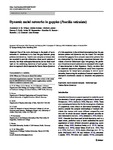Dynamic social networks in guppies (Poecilia reticulata)
| dc.contributor.author | Wilson, Alexander | |
| dc.contributor.author | Krause, S | |
| dc.contributor.author | James, R | |
| dc.contributor.author | Croft, DP | |
| dc.contributor.author | Ramnarine, IW | |
| dc.contributor.author | Borner, KK | |
| dc.contributor.author | Clement, RJG | |
| dc.contributor.author | Krause, J | |
| dc.date.accessioned | 2018-05-09T10:44:05Z | |
| dc.date.available | 2018-05-09T10:44:05Z | |
| dc.date.issued | 2014-06 | |
| dc.identifier.issn | 0340-5443 | |
| dc.identifier.issn | 1432-0762 | |
| dc.identifier.uri | http://hdl.handle.net/10026.1/11471 | |
| dc.description.abstract |
One of the main challenges in the study of social networks in vertebrates is to close the gap between group patterns and dynamics. Usually scan samples or transect data are recorded to provide information about social patterns of animals, but these techniques themselves do not shed much light on the underlying dynamics of such groups. Here we show an approach which captures the fission-fusion dynamics of a fish population in the wild and demonstrates how the gap between pattern and dynamics may be closed. Our analysis revealed that guppies have complex association patterns that are characterised by close strong connections between individuals of similar behavioural type. Intriguingly, the preference for particular social partners is not expressed in the length of associations but in their frequency. Finally, we show that the observed association preferences could have important consequences for transmission processes in animal social networks, thus moving the emphasis of network research from descriptive mechanistic studies to functional and predictive ones. © 2014 Springer-Verlag Berlin Heidelberg. | |
| dc.format.extent | 915-925 | |
| dc.language | en | |
| dc.language.iso | en | |
| dc.publisher | Springer Science and Business Media LLC | |
| dc.subject | Social network analysis | |
| dc.subject | Behaviour type | |
| dc.subject | Fission-fusion dynamics | |
| dc.title | Dynamic social networks in guppies (Poecilia reticulata) | |
| dc.type | journal-article | |
| dc.type | Journal Article | |
| plymouth.author-url | https://www.webofscience.com/api/gateway?GWVersion=2&SrcApp=PARTNER_APP&SrcAuth=LinksAMR&KeyUT=WOS:000336022700004&DestLinkType=FullRecord&DestApp=ALL_WOS&UsrCustomerID=11bb513d99f797142bcfeffcc58ea008 | |
| plymouth.issue | 6 | |
| plymouth.volume | 68 | |
| plymouth.publication-status | Published | |
| plymouth.journal | Behavioral Ecology and Sociobiology | |
| dc.identifier.doi | 10.1007/s00265-014-1704-0 | |
| plymouth.organisational-group | /Plymouth | |
| plymouth.organisational-group | /Plymouth/Faculty of Science and Engineering | |
| plymouth.organisational-group | /Plymouth/Faculty of Science and Engineering/School of Biological and Marine Sciences | |
| plymouth.organisational-group | /Plymouth/REF 2021 Researchers by UoA | |
| plymouth.organisational-group | /Plymouth/REF 2021 Researchers by UoA/UoA07 Earth Systems and Environmental Sciences | |
| plymouth.organisational-group | /Plymouth/Users by role | |
| plymouth.organisational-group | /Plymouth/Users by role/Academics | |
| dc.identifier.eissn | 1432-0762 | |
| dc.rights.embargoperiod | Not known | |
| rioxxterms.versionofrecord | 10.1007/s00265-014-1704-0 | |
| rioxxterms.licenseref.uri | http://www.rioxx.net/licenses/all-rights-reserved | |
| rioxxterms.type | Journal Article/Review |


